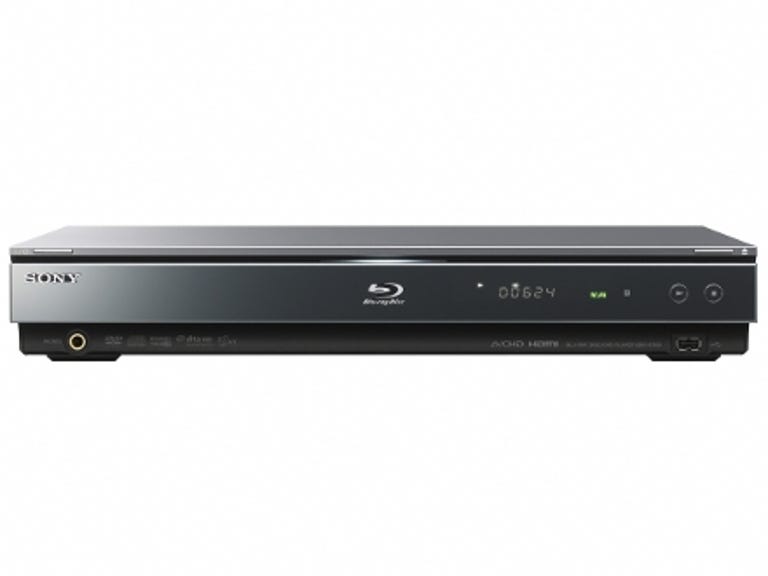 Why You Can Trust CNET
Why You Can Trust CNET Sony BDP-S760 review: Sony BDP-S760
At last, Sony has delivered the awesome stand-alone Blu-ray player that we always knew it was capable of making. Aesthetically, the BDP-S760 is about as original as cake, and a few other recent players may have more features, but it delivers the best Blu-ray pictures we've seen this side of £500
Sony badly fumbled the ball with its early stand-alone Blu-ray players. But the company has slowly been catching up with the competition ever since. Now, with the £330 BDP-S760, it's surged ahead of the pack for the very first time, at least when it comes to AV quality.
The Good
The Bad
The Bottom Line
Ugly duckling
The BDP-S760 isn't aesthetically brilliant, though. It's all very shiny, but the finish feels rather plasticky, and the drop-down smoked-plastic screen over the front is about as original as cake.
The player starts making a better impression once you get to its connections. Our eye was immediately caught, for instance, by the headphone jack on the front. This is quite an unusual feature to find on a Blu-ray player, but the BDP-S760 doesn't stop there. Sony has attempted to provide a 7.1-channel surround-sound experience when listening to the deck through headphones, although it is, admittedly, fairly limited.
There are two USB sockets, too -- one on the front for playing back JPEG photos from USB storage devices, and one on the back for attaching a USB hard disk to provide the BDP-S760 with extra memory.
The deck also carries 7.1-channel analogue audio outputs for outputting decoded high-definition audio (DTS-HD and Dolby TrueHD) to AV receivers that don't have their own HD decoding built in. There's also an Ethernet jack, as we'd expect with pretty much any Blu-ray player these days. The Ethernet socket allows you to access Blu-ray's online BD-Live functions, as does the built-in 802.11n Wi-Fi connectivity. You can also access JPEGs on your PC via either the Wi-Fi or Ethernet connections.
Logging the BDP-S760 onto your network is a doddle -- pretty much everything happens seamlessly behind the scenes. There will always be some routers somewhere that might cause a problem with the BDP-S760, but we suspect they'll be few and far between.
With LG's BD390 still fresh in our minds, we should point out that it's much more multimedia-savvy than the BDP-S760 in terms of the sheer number of different file types it can handle. The BD390 also lets you access YouTube online, while the BDP-S760 doesn't. In fact, the BDP-S760 doesn't even let you access the currently rather unimpressive Sony AppliCast online system that's available on some of the company's TVs.
The BD390 also highlights another shortcoming of the BDP-S760. While the BD390 has 1GB of built-in memory for use with BD-Live, the BDP-S760 has none. Instead, you're expected to introduce memory yourself via the rear USB port, using a not-included USB storage device.
Truly ace pictures
With previous generations of its Blu-ray players, Sony has been caught well and truly on the hop by Panasonic in terms of video processing. But Sony has apparently been beavering away to put together something that finally rivals the video-processing chops of Panasonic's machines.
The BDP-S760 borrows two key pieces of software from Sony's ultra-high-end BDP-S5000ES Blu-ray player: HD Reality Enhancer and Super Bit Mapping. The former of these ridiculously named tools apparently smoothes the image tone and reduces noise (presumably not including the Blu-ray filmic grain that movie buffs love so much). The latter apparently tries to adapt the output image to the 8-, 10- or 12-bit depth of your screen, in a bid to make colours look as natural as your TV can make them. The BDP-S760 also includes Sony's redoubtable Precision Cinema HD system for upscaling standard-definition fare to 1080p HD.
It's easy to be cynical about picture-processing systems, since pretty much every Blu-ray player you care to mention has some sort of image-tweaking feature that its manufacturer wants to shout about. In the case of the BDP-S760 though, they really work, helping to deliver truly brilliant picture quality.
Our concerns about HD Reality Enhancer damaging the picture proved entirely unfounded. In our opinion, it makes HD pictures look achingly lovely -- all mesmerising fine detail, gorgeously balanced colours and immaculate noise suppression. It has to be said that the BDP-S760's pictures still look mighty fine without the HD Reality Enhancer engaged. But, provided you're careful with some of the adjustments connected to it, we're pretty sure you'll want to leave this feature on.
Pictures also demonstrate the player's impressive judder-handling capability, and immaculate reproduction of curved edges. The BDP-S760 delivers the best Blu-ray pictures we've seen this side of £500, and some of the finest pictures we've seen at any price.
Audiophiles will be chuffed to learn that Sony has also gone to town with the BDP-S760's sound capabilities. It's far more capable, with CD playback at least, than any cheaper decks we can think of.
Conclusion
Having recently seen LG's BD390, it's easy to knock the Sony BDP-S760 in terms of features. But there's no doubt that the BDP-S760 wins out when it comes to AV quality. If performance matters more to you than multimedia-playback capability and built-in memory, the BDP-S760 is as good a way to blow £330 as we can think of.
Edited by Charles Kloet
